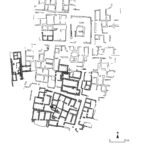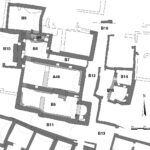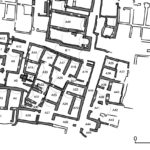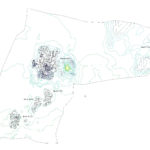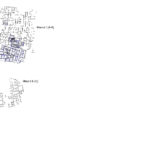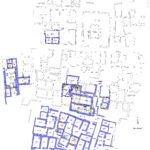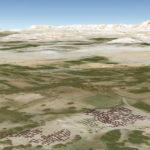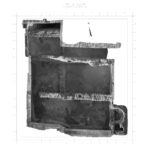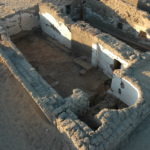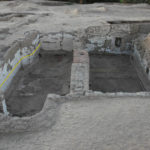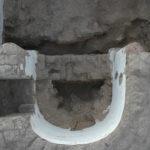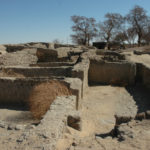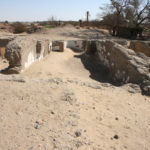ʿAYN AL-ǦADĪDA
| Arabic | عين الجديدة |
| DEChriM ID | 11 |
| Trismegistos GeoID | 3126 |
| Pleiades ID | 861854258 | PAThs ID | 175 |
| Ancient name | - |
| Modern name | ʿAyn al-Ǧadīda |
| Latitude | 25.540111 |
| Longitude | 29.045111 |
| Date from | - |
| Date to | - |
| Typology | Village |
| Dating criteria | - |
| Description | The settlement of ʿAyn al-Ǧadīda, DOP site number 31/405-N3-1, is situated in Dakhla Oasis, c. 2.5 km northwest of the village of Ismant and c. 5 km northwest of the ancient site of Ismant al-Ḫarāb, ancient Kellis, with which it appears to have functioned in association. The site comprises five low hills, denoted mounds I-V, of which mound I is the largest; it is only here that excavation work had been conducted. In addition to numerous domestic structures, a church complex was revealed in the central area of the mound. The single-nave church (B5) developed out of a pre-existent east-west oriented building with the addition of an easterly apse which protruded into B12, a north-south running street to the east of the church, thus interrupting circulation. The structure is adjoined to the north by a curious open hall (A46), through which one entered the church. A second opening between the two spaces contained a podium, attesting to the fact that A46 functioned in association with the church, though in exactly what form remains unclear (Aravecchia 2022). The remainder of the complex is formed by various spaces to the north of B5 and A46, including areas for food preparation (B6). Further attestation of Christianity at the site derives from the documentary sources, including at least one ostracon (no. 1) and several inscriptions within the church complex (Aravecchia et al. 2018: 512, 529-538). It has been hypothesised that the site served as a monastic settlement on account of the clustered configuration of the southern part of mound I which, rather than comprising independent domestic units, appears to have a spatial arrangement intended to serve those living a communal life (Aravecchia et al. 2018: 275-282). Although the Christian ostracon indeed references two apas, this is not sufficient evidence to demonstrate the hypothesis. The fourth century occupation of the site is well attested, with the ceramic corpus spanning from the early fourth to the beginning of the fifth century CE, with very few exceptions (Aravecchia et al. 2018: 285-446). Additionally, 11/12 ostraca and at least 27 coins, though likely more, are attributable to this period (Aravecchia et al. 2018: 447-507). The most significant evidence for pre-fourth century occupation at the site is the apparent temple, the so-called “West Complex”, situated near the western edge of mound I (Aravecchia et al. 2018: 262-268). |
| Archaeological research | The first work conducted on the site was a preliminary survey undertaken by the Dakhleh Oasis Project (DOP) in 1980. This was followed by three seasons of excavation carried out by the Supreme Council of Antiquities between 1993 and 1995, directed by Ahmed Salem and Kamel Bayoumi (Bayumi 1998). The most recent, and extensive, work is that of an American mission directed by Roger Bagnall (in collaboration with Ahmed Salem from 2006-2009), with Nicola Aravecchia acting as field director. Three excavation seasons were conducted (2006-2008), all of which were financed by Columbia University, while two study seasons occurred under the auspices of New York University (2009-2010). This work expanded upon that conducted by the SCA in Area A, and expanded to Area B, with topographical surveys conducted on mounds II-V. |
• Aravecchia, N. 2006. “Ain al Gadida 2006 Excavations: Field Director’s Report.” Accessed April 21, 2020. https://www.amheida.org/inc/pdf/Report2006AG.pdf
• Aravecchia, N. 2007. “Ain el-Gedida 2007 Excavations: Field Director’s Report.” Accessed April 21, 2020. https://www.amheida.org/inc/pdf/Report2007AG.pdf
• Aravecchia, N. 2008. “Ain el-Gedida 2008 Excavations: Field Director’s Report.” Accessed April 21, 2020. https://www.amheida.org/inc/pdf/Report2008AG.pdf
• Aravecchia, N. 2009a. “Ain el-Gedida 2009 Study Season: Field Director’s Report.” Accessed April 21, 2020. https://www.amheida.org/inc/pdf/Report2009AG.pdf
• Aravecchia, N. 2009b. "Christians of the Western Desert in Late Antiquity: the Fourth-Century Church Complex of ‘Ain el-Gedida, Upper Egypt." Ph.D. Dissertations, University of Minnesota.
• Aravecchia, N. 2010. “Ain el-Gedida 2010 Study Season: Field Director’s Report.” Accessed April 21, 2020. https://www.amheida.org/inc/pdf/Report2010AG.pdf
• Aravecchia, N. 2012. “The Church Complex of 'Ain el-Gedida, Dakhleh Oasis.” In The Oasis Papers 6: Proceedings of the Sixth International Conference of the Dakhleh Oasis Project, edited by R.S. Bagnall, P. Davoli and C.A. Hope, 391-408. Oxford: Oxbow.
• Aravecchia, N. 2015. “Christianity at Trimithis and in the Dakhla Oasis.” In An Oasis City, edited by R. S. Bagnall, N. Aravecchia, R. Cribiore, P. Davoli, O. E. Kaper and S. McFadden, 119-148. New York: NYU Press.
• Aravecchia, N. 2018. Amheida IV. ‘Ain el-Gedida: 2006-2008 Excavations of a Late Antique Site in Egypt’s Western Desert. New York: New York University Press.
• Aravecchia, N 2022. “Catechumens, Women, and Agricultural Laborers: Who Used the Fourth-Century Hall at the Church of Ayn el-Gedida, Egypt?” Journal of Late Antiquity 15, 1: 193-230.
• Bayumi, K. 1998. “Excavations at ‘Ain al Gadida in the Dakhleh Oasis.” In Life on the Fringe. Living in the Southern Egyptian Deserts during the Roman and early-Byzantine Periods, edited by O. E. Kaper, 55-62. Leiden: Research School CNWS, School of Asian, African, and Amerindian Studies.
• Blondaux, L. 2008. Painted Plaster from ʿAin el-Gedida. Unpublished.
• Bowen, G. E. 2019. “Christianity in Dakhleh Oasis: An Archaeological Overview.” In The Oasis Papers 9, A tribute to Anthony J. Mills after Forty Years of Research in Dakhleh Oasis. Proceedings of the Ninth International conference of the Dakhleh Oasis Projects, edited by Gillian E. Bowen and Colin A. Hope, with the assistance of Bruce E. Parr, 369. Oxford and Philadelphia: Oxbow Books.
• Dixneuf, D. 2012. “Ceramics from ‘Ain el- Gedida, Dakhleh Oasis: Preliminary Results.” In The Oasis Papers 6: Proceedings of the Sixth International Conference of the Dakhleh Oasis, edited by R. S. Bagnall, P. Davoli and C. A. Hope, 495-70. Oxford: Oxbow Books.
• Ghica, V. 2012. “Pour une histoire du christianisme dans le désert occidental d’Égypte.” Journal des Savants 2: 189-280.
• Ghica, V. 2016. “Vecteurs de la christianisation de l’Egypte au IVe siècle à la lumière des sources archéologiques.” In Acta XVI Congressus Internationalis Archaeologiae Christianae, Rome 22-28.9.2013, edited by Olof Brandt and Gabriele Castiglia, 241 and fig. 9f. Città del Vaticano: Pontificio Istituto di Archeologia Cristiana.
• Mills, A. J. and K. A. Worp. 2000. “A Poll Tax Receipt from el-Gedida (Dhakhleh Oasis).” Zeitschrift für Papyrologie und Epigraphik 133: 187-9.
• Pike, G. 2006. ‘Ain el-Gedida 2006: Pottery. Unpublished.


 Json data
Json data